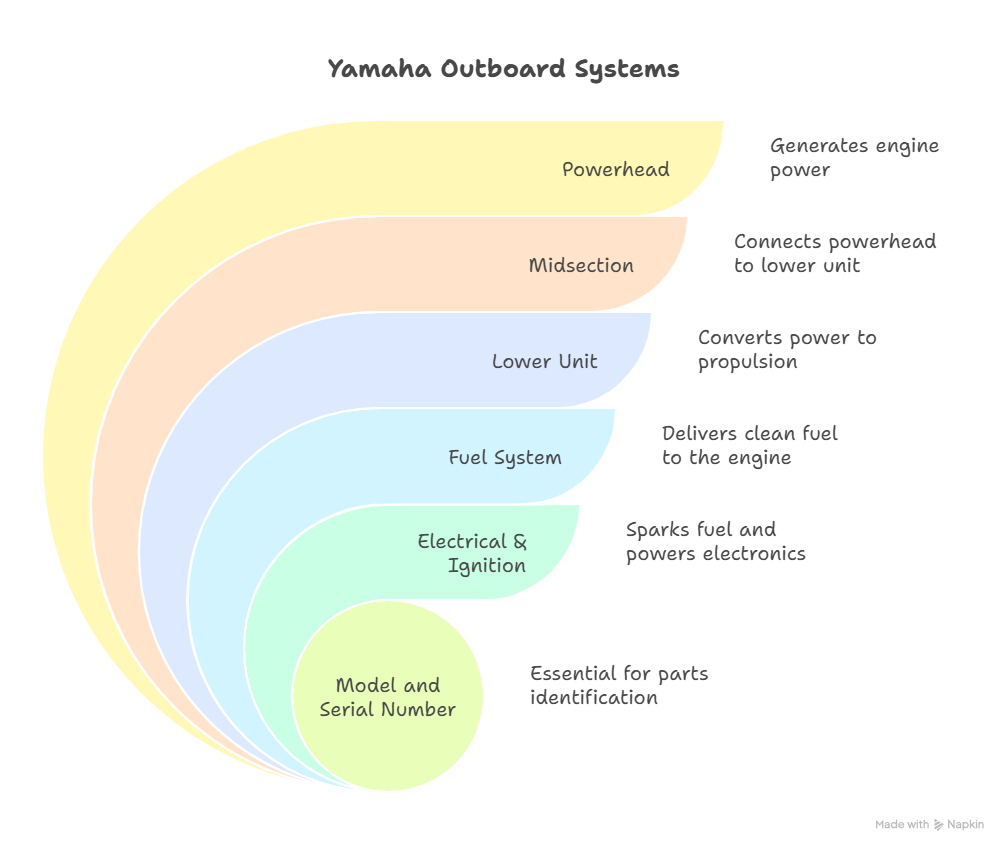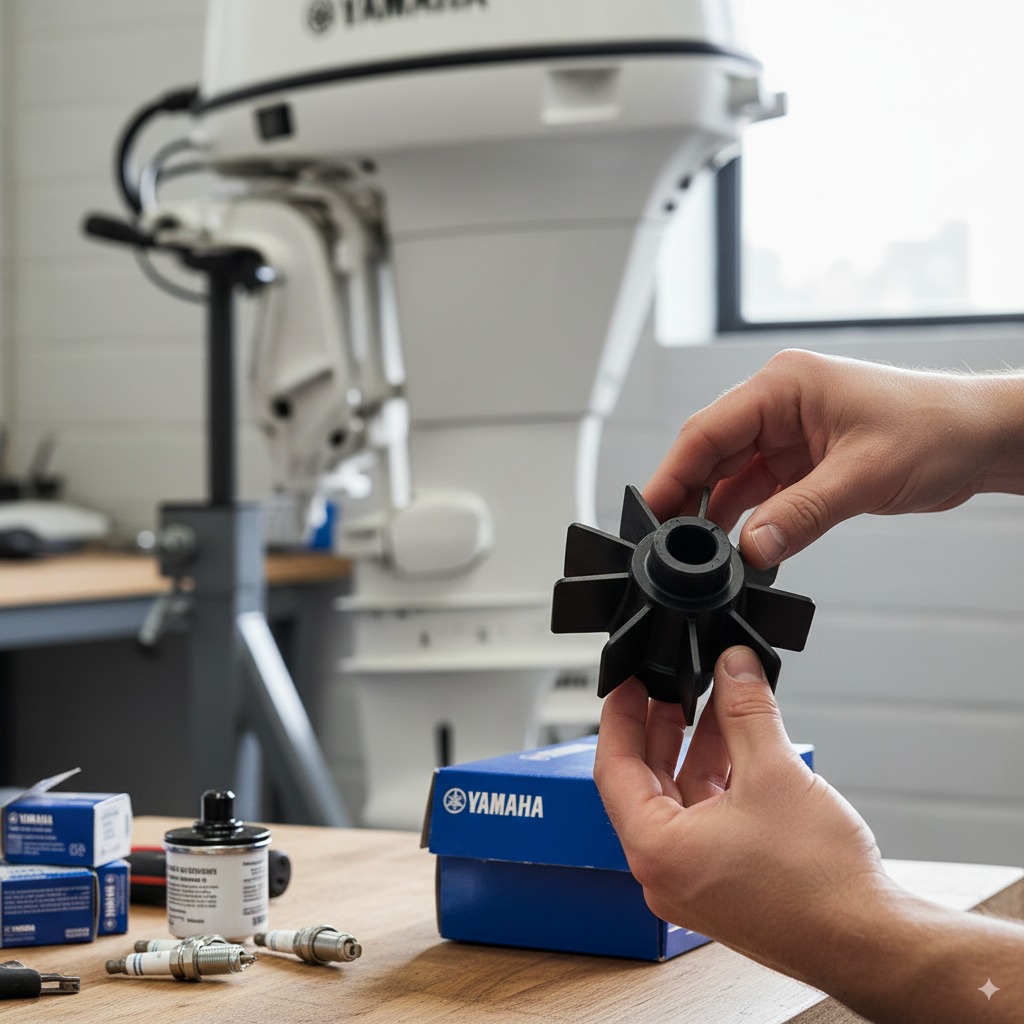I’m Alex, and for the last 15 years, I’ve been the guy boaters in Miami call when their perfect day gets ruined by a sputtering engine. There’s nothing worse. One minute you’re cruising, the next you’re dead in the water. More often than not, the culprit is a small, failed part that could have been easily replaced.
I’ll never forget a guy named Mike with a beautiful Contender running twin Yamaha F250s. He called me in a panic, stranded a few miles off Key Biscayne. He was convinced he’d blown a powerhead and was already pricing new motors in his head. I got out there, and what did I find? A single, hopelessly clogged fuel filter. He’d used a cheap, no-name part. We swapped it for a genuine Yamaha outboards parts filter I had in my truck, and those engines fired right up. He went from facing a $50,000 problem in his mind to a $50 fix.
That’s why we’re here. Understanding the right Yamaha outboards parts to use and when to use them isn’t just about repairs; it’s about peace of mind. It’s the difference between a ruined day and a minor inconvenience. In this guide, I’m going to give you the straight scoop—no fluff—on how to keep your Yamaha humming with the right parts and a little bit of know-how.
Table of Contents
Getting to Know Your Yamaha: The Core Systems
Before you can fix it, you have to know what you’re looking at. A Yamaha outboard is a beautifully engineered machine, but it boils down to a few key systems.
- The Powerhead: This is the heart and soul. It’s the engine itself—pistons, cylinders, crankshaft. This is where the power is made.
- The Midsection: Think of this as the spine. It connects the powerhead to the lower unit and contains your exhaust and trim/tilt system.
- The Lower Unit: The workhorse. This is the gearbox that lives underwater, turning the engine’s power into propulsion at the propeller. It also houses the water pump, which is critical for cooling.
- The Fuel System: The engine’s lifeline. It has to deliver perfectly clean fuel. A problem here, like with Mike’s boat, is the number one reason I get called for Yamaha outboards parts-related service.
- Electrical & Ignition: The spark of life. This system creates the spark that ignites the fuel and powers all your boat’s electronics.
The most important piece of information on your entire motor is the model and serial number plate. It’s usually on the mounting bracket. Without it, ordering the correct Yamaha outboards parts is a guessing game you don’t want to play.

OEM vs. Aftermarket: A Mechanic’s Take on Parts
This is the big debate: do you spend the extra money on genuine OEM Yamaha outboards parts, or can you get away with cheaper aftermarket stuff? Here’s the table I share with my clients.
| Part Type | My Recommendation | Why I Say That |
|---|---|---|
| Water Pump Impeller | OEM Only | This is not the place to save $20. A failed impeller will cook your engine. The OEM rubber compound is designed for the job. |
| Fuel & Oil Filters | OEM Recommended | Genuine filters have the right micron rating and flow rate. A cheap filter can either clog too fast or let junk into your injectors. |
| Spark Plugs | OEM or Top-Tier Aftermarket | NGK makes the plugs for Yamaha. As long as you get the exact right plug, you’re fine. But stick to the OEM recommendation. |
| Anodes (Zincs) | Good Aftermarket is OK | Anodes are designed to be eaten away. As long as the alloy is correct for your water type (zinc for salt, aluminum for brackish), you’re good. |
| Gaskets & Seals | OEM Recommended | Fit is everything. An OEM gasket is guaranteed to seal perfectly. An ill-fitting aftermarket one can cause a nasty leak. |
| Propellers | Varies | For general use, OEM is great. But for performance, specialized aftermarket props can offer a real upgrade. |
My rule of thumb: if it’s a part that can cause catastrophic failure if it breaks, spend the money on genuine Yamaha outboards parts. It’s the cheapest insurance you can buy.
Keeping It Healthy: A Proactive Maintenance Plan
You don’t wait for your truck to break down to change the oil. Your Yamaha is no different. Sticking to Yamaha’s service intervals (a 20-hour check, then every 100 hours or annually) is the single best way to avoid seeing me for an emergency call.
Here’s what I focus on during a typical Yamaha outboards parts service check:
- Fuel System: I can’t say this enough: clean fuel is everything. I check and replace all fuel filters, inspect lines, and drain the water separator.
- Cooling System: I inspect the impeller every year and recommend replacing it every two, regardless of how it looks. It’s a cheap part that prevents an expensive problem. I also make sure to flush the engine with fresh water after every single saltwater run.
- Electrical: I check battery terminals for corrosion—that fuzzy green stuff is a power killer. A little dielectric grease goes a long way.
- Lower Unit: I change the gear lube annually. I’m looking for that milky, coffee-colored fluid that tells me water is getting in past a bad seal.
When It Sputters: Diagnosing Common Problems
Even the best-maintained Yamaha can have a bad day. When it does, don’t just start throwing Yamaha outboards parts at it. Think systematically.
- Problem: Engine Won’t Start. Is it turning over? If yes, you have a fuel or spark problem. Check the simple stuff first: kill switch, fuel in the tank, primer bulb. If no, you have an electrical problem. Start at the battery.
- Problem: Engine is Overheating. You see the alarm on your dash or steam coming off the cowling. Shut it down immediately. The first thing to check is the water pump telltale stream. If it’s weak or absent, you’ve likely got a cooling system blockage or a failed impeller.
- Problem: Loss of Power. This often points to fuel delivery. You could have a clogged filter, a weak fuel pump, or fouled injectors. It could also be a fouled spark plug causing a cylinder to drop out.
Having a few basic diagnostic tools like a multimeter, a fuel pressure gauge, and a compression tester can help you narrow down the problem before you have to call a pro.
Performance Boosts: Getting More from Your Yamaha
Sometimes, stock isn’t enough. You can make some smart upgrades using specialized Yamaha outboards parts or aftermarket components to get more performance.
- Propeller Upgrade: This is the easiest and most effective upgrade. Swapping to a different pitch or a stainless steel prop can dramatically improve your boat’s holeshot, top speed, or fuel economy.
- ECU Re-flashing: For the serious performance junkie. Companies like Nizpro can tune your engine’s computer to unlock more horsepower. Just be aware, this will likely void your warranty.
- Jack Plate: This lets you adjust the engine’s height on the fly, reducing drag and maximizing speed. It’s a game-changer on high-performance hulls.
FAQ: Questions I Get Asked at the Marina
Are aftermarket Yamaha outboards parts really that bad?
Not all of them. For non-critical parts like anodes or propellers, some aftermarket brands are excellent. But for core engine components, I always lean towards OEM. The risk just isn’t worth the savings.
What’s the most common failure you see on Yamahas?
Fuel-related issues, by a long shot. Clogged filters, bad fuel, or injector problems. People are often not as careful with their fuel as they should be.
What spare Yamaha outboards parts should I absolutely carry on my boat?
At a minimum: a spare fuel filter, a set of spark plugs, and a prop nut kit with a wrench. That small kit will solve 80% of common on-the-water problems.
How do I make sure I’m ordering the right part online?
Use your full model and serial number. Reputable online stores have diagrams (schematics) where you can visually identify the exact part and get the right part number. Double-check it before you click “buy.”
Is it worth it to pay more for a Yamaha-certified mechanic?
For complex jobs or warranty work, absolutely. They have the training and the specialized diagnostic software. For a simple oil change, any competent marine mechanic will do, but for a tricky electrical issue, the certified guy will probably find it faster.
The Bottom Line: My Final Advice
Taking care of your Yamaha isn’t black magic. It’s about being smart, proactive, and using the right Yamaha outboards parts. If you want to spend more time cruising and less time worrying, here’s what it boils down to:
- Trust Genuine Parts for a Genuine Fix: For the important stuff, use OEM Yamaha outboards parts. You’ll sleep better at night.
- Follow the Service Schedule: Yamaha created it for a reason. 100 hours or once a year. Don’t skip it.
- Keep a Few Spares Onboard: A small kit of essential parts can turn a tow-call into a 15-minute fix.
- Listen to Your Engine: If it sounds or feels different, it’s trying to tell you something. Investigate it.
- Know When to Call for Help: Don’t be afraid to call a pro. Sometimes, paying a mechanic for an hour of their time is the cheapest and fastest way to get back on the water.
Your Yamaha is a fantastic engine. Treat it right with quality Yamaha outboards parts and regular care, and it will give you years of reliable service.
Author Bio
I’m Alex, a 15-year, ABYC-certified marine technician based in South Florida. I specialize in Yamaha outboards, and I’ve serviced everything from the trusty F150 to the big XTOs. My shop has become the go-to place for reliable diagnostics and sourcing the right Yamaha outboards parts for boaters from Dinner Key to Bahia Mar.


Leave a Reply